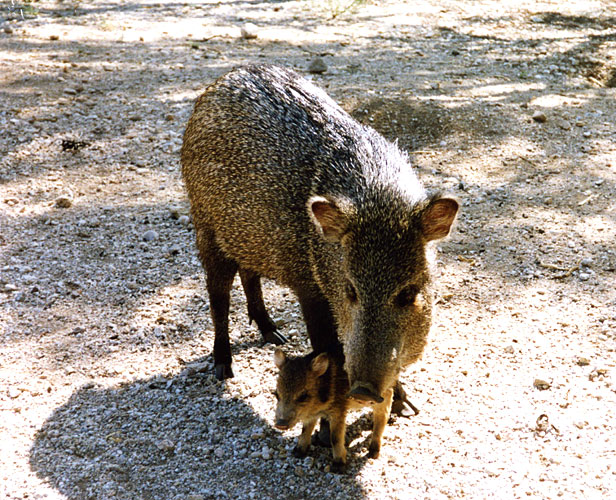

A javelina mother and baby at our old house.
|
If you
would like to use the information |
What the Heck is a Javelina?
"Javelina" (have-eh-LEEN-ah) is the commonly-used name for the Collared Peccary. There are two other species of peccary (the White-Lipped and the Chacoan), both of which are native to South America. The Collared Peccary lives in Mexico and the far southwestern United States.
Peccaries belong to the family Tayassuidae and are distantly related to pigs, who are in the family Suidae. They have quite a few characteristics in common with pigs, including a mobile snout and a healthy appetite, but there are definite anatomical differences between the two, though I'm not familiar enough with them to explain them here. One difference between peccaries and pigs is evident in the picture above: javelina have one or two babies at a time rather than producing large litters like pigs do.
NOTE:
For more information about javelinas/peccaries, see the Jungle Photos page here.
Javelina have a light-colored stripe that runs around the neck and shoulder area, resembling a collar. Males and females both have collars, and the marking is visible even on tiny babies.
I've never seen a White-Lipped peccary, but I imagine their name is self-explanatory, too.
There are a few theories about the origin of the word "javelina." The most common one says the name comes from the word "javelin" and is a reference to the javelina's long, fearsome-looking teeth, which sounds a bit far-fetched to me. Another theory says the Spanish word "jabalí" is the source. A jabalí is a wild boar. A wild sow is a jabalina. My bet is on this theory.
Whichever theory is correct, these animals are called javelina a lot more often than they're called Collared Peccaries. I'd be willing to bet most people living in this area have never heard the latter name. Of course, some people are so confused about the name "javelina" that they probably couldn't cope with two names, anyway. I've heard several anecdotes involving people talking about herds of wild jalapeños...
They are wild animals; however, as more and more people move here and bulldoze the javelinas' habitat, more and more javelina wind up living in close proximity to people. Like coyotes, javelina seem to adapt very readily to being urban wildlife. Unlike coyotes, they become rapidly habituated to people and can make real nuisances of themselves.
Apart from knocking over trash cans, eating people's dog food and bird seed, and uprooting expensively-landscaped yards, javelina accustomed to being fed by people can be aggressive beggars. They don't see well, and if startled, may bite - and those long, dagger-like incisors can do real damage.
It is unlikely that people in this area are going to quit bulldozing and building anytime soon, so hopefully, they can find it in themselves to share the remaining land with javelina and other animals.
Two herds of javelina lived near our former residence. Not long after we moved in, I heard rustling noises outside the kitchen door and peeked through the window to see several javelina roaming around the property. I had never seen javelina in the wild before, and was ecstatic. There was a low brick wall outside the kitchen door, so I figured I would creep outside, use the wall as a blind, and observe the javelina safely at fairly close range. I got outside without disturbing them and ducked behind the wall, where I remained totally concealed for several minutes to make sure I didn't spook them. After some time, I peered cautiously over the edge of the wall to see what they were doing, and to my surprise, got an extremely close-up view of two snouts. Two herd members had become curious as to what I was doing and were trying to see over the wall. As it turned out, these javelina were quite used to people...
We saw both herds frequently. We called one herd the Shy Herd, as they were still a bit wary of people. We dubbed the other herd the Rude Herd because they were demanding beggars and very used to people. Most of my pictures are of Rude Herd members, some of whom seemed to enjoy posing and weren't the slightest bit concerned about bringing their tiny newborn babies around. The Rude Herd was run by a large, bossy, beat-up looking older female we called Grandma. She tolerated no nonsense from anyone - javelina or human.
When we left our old place to move into our current residence, the area was being heavily developed. I hope both herds are doing well in spite of this. There are javelina in the area where we currently live, but we rarely see them because they aren't being crowded by overdevelopment and still have their natural fear of humans. That's the way things are meant to be.
Don't. It's not a good idea. In some of my pictures, you'll see them eating carrots and potatoes and such. At the time, we reasoned that these particular javelina were already used to people and used to receiving handouts, so we weren't doing any harm by feeding them. In hindsight, it wasn't a good idea.
Wild animals need to eat the food they're meant to eat naturally, not "people food." As mentioned above, they can also become dangerous when they start to view people as food suppliers.